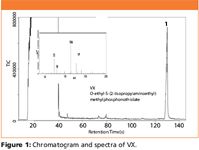Rapid Field Detection of Chemical Warfare Agents, Simulants, By-Products, and Precursors Using Solid Phase Microextraction and Portable GC-TMS
The Application Notebook
Rapid sample preparation using the CUSTODIONâ„¢ solid phase microextraction (SPME) syringe was applied to chemical warfare agents (CWAs), CWA simulants, by-products, and precursors. The samples were analyzed quickly and reliably with a sample-to-sample cycle time of less than 3 min using the GUARDIONâ„¢-7 portable capillary gas chromatograph toroidal ion trap mass spectrometer (GC–TMS).
Rapid sample preparation using the CUSTODION™ solid phase microextraction (SPME) syringe was applied to chemical warfare agents (CWAs), CWA simulants, by-products, and precursors. The samples were analyzed quickly and reliably with a sample-to-sample cycle time of less than 3 min using the GUARDION™-7 portable capillary gas chromatograph toroidal ion trap mass spectrometer (GC–TMS).
Rapid and accurate detection of chemical warfare agents (CWAs), CWA precursors, and CWA by-products is imperative for human protection in warfare and security domains. Gas chromatography–mass spectrometry (GC–MS) is a selective and sensitive technique routinely used in laboratory settings. Now, GC–MS can be applied for near-real time detection of CWAs over a broad concentration range in situations requiring mobile analysis using a hand-portable GUARDION™-7 GC–TMS instrument in the field. Rapid sample preparation for air, headspace, liquids, and dissolved solid samples is accomplished by solid phase microextraction (SPME). In this application, low concentrations of CWAs, and low to neat (100%) concentrations of CWA precursors, simulants, and by-products were sampled and identified in less than 3 min.
Experimental Conditions
Six CWAs including VX, HD, HN3, GA, GB, and GD were prepared at 100 μg/ml in isopropyl alcohol. A CUSTODION SPME syringe with a 65 μm polydimethylsiloxane/divinylbenzene (PDMS/DVB) fiber was used for extraction by immersing the fiber directly into the sample for 5 s. The CWA simulants, by-products, and precursors including diisopropylmethylphosphonate (DIMP), methyl salicylate (MES), tributylphosphate (TBP), pinacolyl alcohol (PA), diethylmalonate (DEM), and dimethylmethylphosphonate (DMMP) were sampled in separate analytical runs at concentrations ranging from trace to neat (100%) for 5 s.
Following each sample preparation, the SPME syringe was inserted into the GUARDION-7 GC-TMS injection port where the target analytes were desorbed into a low thermal mass injector (275 °C) coupled with a metal-clad capillary GC column (MXT-5, 5 m × 0.1 mm, 0.4 μm df). After an initial 10 s hold at 50 °C, the GC temperature was increased at 2 °C/s to 280 °C. The capillary GC is coupled to a TMS detector having a mass range of 45–500 m/z. A user defined compound library identified the target analytes using an on-board deconvolution algorithm.
Results
Figure 1 shows the GC–TMS chromatogram and mass spectrum for VX prepared in isopropyl alcohol after preparation at below regulated surety level. VX was positively identified by the GUARDION-7 in 130 s.

Figure 1
Conclusions
The CUSTODION™ SPME syringe and GUARDION™-7 GC–TMS are uniquely suited for field or laboratory screening of CWAs and other organic compounds to support rapid decision making. The ability to analyze a wide variety of sample types at concentrations from trace to neat allows the CUSTODION SPME syringe and GUARDION-7 GC–TMS to provide near real-time field analysis results. The short cycle time between injections allows the user to quickly analyze samples on-site with high sensitivity and specificity.
Acknowledgements
CUSTODION™ and GUARDION™ are registered trademarks of Torion Technologies Inc. The CUSTODION SPME syringes are manufactured and sold under license from (1) Brigham Young University under US Patent Application 11/379,716 and (2) SUPELCO under US Patent 5,691,206, and/or any divisions, continuations, or revisions thereof.

Torion Technologies Inc.
796 East Utah Valley Drive, Suite 200, American Fork, UT 84003
tel. (801)705-6600
Website: www.torion.com

A Guide To Finding the Ideal Syringe and Needle
January 20th 2025Hamilton has produced a series of reference guides to assist science professionals in finding the best-suited products and configurations for their applications. The Syringe and Needle Reference Guide provides detailed information on Hamilton Company’s full portfolio of syringes and needles. Everything from cleaning and preventative maintenance to individual part numbers are available for review. It also includes selection charts to help you choose between syringe terminations like cemented needles and luer tips.
Oasis or Sand Dune? Isolation of Psychedelic Compounds
January 20th 2025Magic mushrooms, once taboo, have recently experienced a renaissance. This new awakening is partially due to new findings that indicate the effects of psilocybin, and its dephosphorylated cousin psilocin may produce long lasting results for patients who might be struggling with anxiety, depression, alcohol and drug abuse, and post-traumatic stress disorder. Hamilton Company has developed a methodology for the isolation and identification of 5 common psychedelic compounds used in the potential treatment of disease. The PRP-1 HPLC column resin remains stable in the harsh alkaline conditions ideal for better separations.
GPCRs – The Biological Traffic Modulator: Chromatographic Analysis of Peptides in the GI Tract
January 20th 2025The G protein-coupled receptors (GPCR) are found throughout the entire body and have shown significance in the development of new therapeutic treatments. Isolation of seven classic GRPC peptides initiating in the GI tract highlights the benefits of using the polymer-based PRP-3, a reversed-phase resin. The covalent bonds found in the PRP-3 exhibit advantageous interactions between the biological π bonds found in the peptides and the available aromatic benzyl rings of the resin.